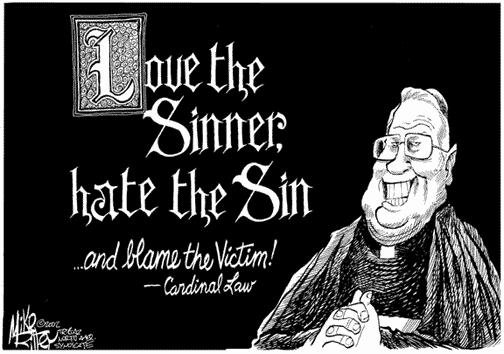
Abused, Ignored, Slandered: Victims of Church-related Violence
For the first time ever, an in-depth report illuminates a taboo subject involving the Roman Catholic Church
(Vienna, November 18, 2010) A hotline unconnected with the Catholic Church has been available to victims of Church-related violence since March 2010.
Callers receive initial counseling from clinical psychologists and legal assistance from lawyers.
The hotline’s report is the first of its kind and reveals a wealth of facts concerning this dark side of the Church. The extent of abuse has been documented extensively for the first time in Austria and is now being published.
For the first time ever, an in-depth report illuminates a taboo subject involving the Roman Catholic Church
(Vienna, November 18, 2010) A hotline unconnected with the Catholic Church has been available to victims of Church-related violence since March 2010.
Callers receive initial counseling from clinical psychologists and legal assistance from lawyers.
The hotline’s report is the first of its kind and reveals a wealth of facts concerning this dark side of the Church. The extent of abuse has been documented extensively for the first time in Austria and is now being published.
bron
 1. SUMMARY
1. SUMMARY
In the first ten days of operation alone, 150 individuals contacted the hotline, and the total has reached 325, 91 women (28%) and 234 men (72%).
- When the abuse took place: While the majority of cases (59,7%) took place in the 1960s and ’70s, 18 individuals have been abused within the last 20 years alone.
abused within the last 20 years alone.
- States: Broken down by state, the majority of reports (73) involved Upper Austria, followed by Vienna (72) and Lower Austria (68).
- Duration of the abuse: For 43.3%, the period of time was between two and five years. Of the women, 17.6% reported time periods of eight years or longer, and nine percent of the males were abused over the same amount of time.
- Age of the victims: Twelve percent of the callers were six years of age or younger when the abuse began. The majority of incidents (79,5%) took place when they were between seven and 14 years old, a period of time during which they first came into contact with parish priests.
- Location: Boarding schools or homes, where children were particularly vulnerable, represent 55.8% of the locations. In many cases, members of socially underprivileged groups were involved. In cases where children confided in their parents, they were normally beaten, either by their parents or members of the Church, and this treatment silenced them.
- Tip of the iceberg: Sixty percent of the callers claimed to know of other children who were subjected to psychological, physical or sexual abuse from the same perpetrator.
- Victims’ interests: While solely 4,1% of victims are interested in obtaining psychotherapy, the majority expressed a desire to combat decades of silence and coverups (54.1%) and obtain information relating to legal action or compensation (41.7%).
 - The accused: The victims named 422 perpetrators of both genders. Of those, 63% were ordained priests (this figure includes both diocesan priests and members of orders). Of the perpetrators named, 20.8% were non-ordained members of an order.
- The accused: The victims named 422 perpetrators of both genders. Of those, 63% were ordained priests (this figure includes both diocesan priests and members of orders). Of the perpetrators named, 20.8% were non-ordained members of an order.
These statistics make it clear that the abuse of children within the Catholic Church represents a significant problem.
- Age and gender of the accused: 43,3% of the perpetrators were between 30 and 39 years of age. The majority, 78.2%, were male.
- Strategies of the abusers: Of the perpetrators, 40.4% demanded that their victims not tell anyone what had happened. One-fourth threatened damnation and Hell or violence, or claimed that they would be committing a sin if they talked about the abuse. Privileges were often provided.
- Structural causes:
Obviously, the Catholic Church’s positions concerning sexuality – and to a certain extent compulsory celibacy also – increase the amount of danger to which children are exposed significantly, as the number of reports involving Evangelical churches amounted to less than one percent. This figure is far below the statistic for Austrians who belong to one of these churches (five percent).
 It could be said that perpetrators had job security within the Catholic Church: After being accused of abuse, priests were merely transferred. Even those who were convicted in a court of law were put back into positions as pastoral caregivers after serving their sentence, as a result of which they came into contact with new victims. In one example, two priests from other
It could be said that perpetrators had job security within the Catholic Church: After being accused of abuse, priests were merely transferred. Even those who were convicted in a court of law were put back into positions as pastoral caregivers after serving their sentence, as a result of which they came into contact with new victims. In one example, two priests from other
European countries who were convicted of sexually abusing children in their home countries spent decades working in Austrian parishes and boarding schools, where they committed the same crimes again.
Insufficient steps to deal with the problem: The steps taken so far to deal with this scandal are wholly unsatisfactory.
There is no political consciousness of the fact that a comprehensive independent investigation is needed.
 1. SUMMARY
1. SUMMARY In the first ten days of operation alone, 150 individuals contacted the hotline, and the total has reached 325, 91 women (28%) and 234 men (72%).
- When the abuse took place: While the majority of cases (59,7%) took place in the 1960s and ’70s, 18 individuals have been
 abused within the last 20 years alone.
abused within the last 20 years alone.- States: Broken down by state, the majority of reports (73) involved Upper Austria, followed by Vienna (72) and Lower Austria (68).
- Duration of the abuse: For 43.3%, the period of time was between two and five years. Of the women, 17.6% reported time periods of eight years or longer, and nine percent of the males were abused over the same amount of time.
- Age of the victims: Twelve percent of the callers were six years of age or younger when the abuse began. The majority of incidents (79,5%) took place when they were between seven and 14 years old, a period of time during which they first came into contact with parish priests.
- Location: Boarding schools or homes, where children were particularly vulnerable, represent 55.8% of the locations. In many cases, members of socially underprivileged groups were involved. In cases where children confided in their parents, they were normally beaten, either by their parents or members of the Church, and this treatment silenced them.
- Tip of the iceberg: Sixty percent of the callers claimed to know of other children who were subjected to psychological, physical or sexual abuse from the same perpetrator.
- Victims’ interests: While solely 4,1% of victims are interested in obtaining psychotherapy, the majority expressed a desire to combat decades of silence and coverups (54.1%) and obtain information relating to legal action or compensation (41.7%).
 - The accused: The victims named 422 perpetrators of both genders. Of those, 63% were ordained priests (this figure includes both diocesan priests and members of orders). Of the perpetrators named, 20.8% were non-ordained members of an order.
- The accused: The victims named 422 perpetrators of both genders. Of those, 63% were ordained priests (this figure includes both diocesan priests and members of orders). Of the perpetrators named, 20.8% were non-ordained members of an order.These statistics make it clear that the abuse of children within the Catholic Church represents a significant problem.
- Age and gender of the accused: 43,3% of the perpetrators were between 30 and 39 years of age. The majority, 78.2%, were male.
- Strategies of the abusers: Of the perpetrators, 40.4% demanded that their victims not tell anyone what had happened. One-fourth threatened damnation and Hell or violence, or claimed that they would be committing a sin if they talked about the abuse. Privileges were often provided.
- Structural causes:
Obviously, the Catholic Church’s positions concerning sexuality – and to a certain extent compulsory celibacy also – increase the amount of danger to which children are exposed significantly, as the number of reports involving Evangelical churches amounted to less than one percent. This figure is far below the statistic for Austrians who belong to one of these churches (five percent).
 It could be said that perpetrators had job security within the Catholic Church: After being accused of abuse, priests were merely transferred. Even those who were convicted in a court of law were put back into positions as pastoral caregivers after serving their sentence, as a result of which they came into contact with new victims. In one example, two priests from other
It could be said that perpetrators had job security within the Catholic Church: After being accused of abuse, priests were merely transferred. Even those who were convicted in a court of law were put back into positions as pastoral caregivers after serving their sentence, as a result of which they came into contact with new victims. In one example, two priests from otherEuropean countries who were convicted of sexually abusing children in their home countries spent decades working in Austrian parishes and boarding schools, where they committed the same crimes again.
Insufficient steps to deal with the problem: The steps taken so far to deal with this scandal are wholly unsatisfactory.
There is no political consciousness of the fact that a comprehensive independent investigation is needed.
The "Klasnic Commission" is a board of inquiry made up of the groups under accusation.
Complete rapport :
Sexuelle, körperliche und seelische Gewalt gegen Kinder und Jugendliche innerhalb der
römisch katholischen Kirche in Österreich
Sexuelle, körperliche und seelische Gewalt gegen Kinder und Jugendliche innerhalb der
römisch katholischen Kirche in Österreich
Mag. Philipp Schwärzler
clinical psychologist and psychotherapist




















Geen opmerkingen:
Een reactie posten